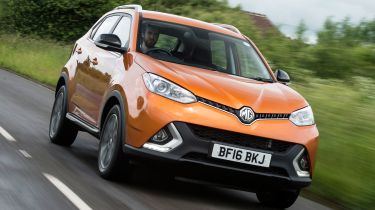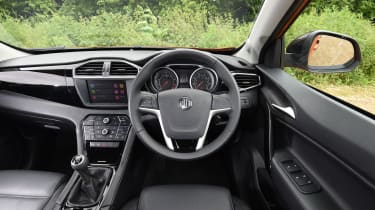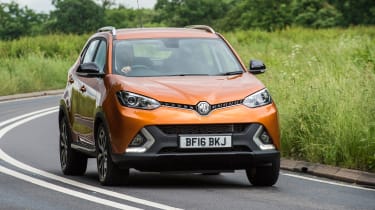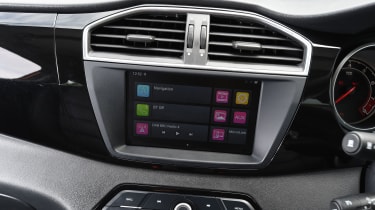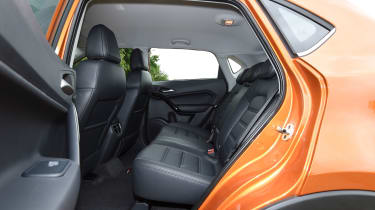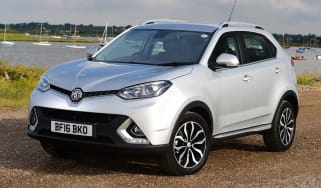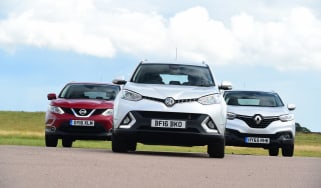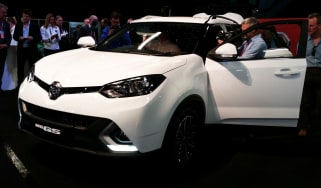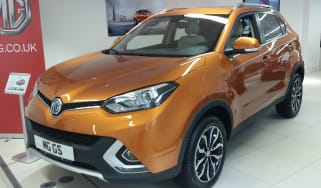MG GS review
The MG GS is the first SUV from the revived British brand, rivalling the Nissan Qashqai

The MG GS is the latest model from the Chinese-owned British brand and the idea behind it is simple: to cash in on the booming SUV market around the world. Buyers can’t get enough of these high-riding, practical cars, and it made perfect sense for MG to build one. So the GS is the first SUV ever from MG and though more are in the pipeline, it’s the only one in the range at the moment.
Buying an MG GS is easy - a limited range means there are very few choices to make compared to many other modern cars. You can go for Explore, Excite or Exclusive trims, and all come with a manual gearbox. You’ll need to go for the Exclusive DCT trim for an automatic version.
• Best crossovers on sale right now
There is also only one engine: a 1.5-litre petrol. All models are front-wheel drive only, which means that despite the SUV styling the GS is clearly not meant for any kind of off-road action.
Its main rivals are the similarly-sized Nissan Qashqai and Renault Kadjar, but the MG’s price tag also invited comparison with budget SUVs such as the Dacia Duster and SsangYong Tivoli.
The GS is based on MG’s new scalable SUV platform, which will underpin a future smaller B-segment crossover to rival the likes of the Renault Captur and Nissan Juke. That car is tipped to go on sale next year. The architecture can also go larger, however, and will form the basis of a new large SUV that’ll compete with the Nissan X-Trail.
Used - available now

2025 Toyota
Yaris Hybrid
37,962 milesAutomaticPetrol1.5L
Cash £14,300
2022 MG
HS
41,109 milesAutomaticPetrol1.5L
Cash £15,663
2023 Tesla
Model 3
26,881 milesAutomaticElectric
Cash £21,000
2019 Ford
Kuga
69,946 milesAutomaticDiesel2.0L
Cash £11,763The MG GS is a disappointing first SUV effort from MG. It’s not an absolute disaster but the GS just doesn’t do anything that its rivals don’t do better. The entry level models stack-up reasonably well as budget options but higher spec cars are a long way off the pace.
It’s not particularly good to drive and the design is nothing special next to rivals such as the Renault Kadjar. The 1.5-litre petrol engine isn’t very economical and refinement is no better than than the diesels available in rival cars. The interior quality is poor as well, even small details such as the display screen that faces away from the driver hurt the MG’s appeal. The GS is practical, however, with a useful boot space and a roomy cabin.
Engines, performance and drive
Family SUVs aren’t about seat-of-the-pants thrills on the road but even by the standards of the class, the GS is quite a way behind the best.
For starters, it’s unrefined – the GS is fine around town but rev the engine out a bit and it makes a boomy drone. There are noticeable flatspots in its rev range where the power delivery stutters, while the car needs to be revved to get the best out of it. It may be faster on paper than similarly priced rivals but the MG GS is not as pleasant to extract performance from.
The dual-clutch transmission isn’t a swift-shifting unit like a VW Group DSG gearbox. Instead, it holds onto ratios far too long and makes the engine feel laboured. Then when it eventually changes up, the shift sometimes comes with a jerk. It’s this inconsistent response that makes it so frustrating.
The six-speed manual gearbox is a better choice than the expensive and flawed dual-clutch auto, but it’s not perfect either. The shift has a long throw, feels rubbery, and it’s easy to miss a gear if you’re not concentrating. Combine that with the sharp clutch and it’s not as easy to drive as most buyers would like.
Once up to speed the GS is reasonably refined, although wind noise is noticeable. Road noise is kept in check well, too. Just as the gearbox is inconsistent, so too is the way the suspension deals with bumps. Sometimes the dampers will filter out bad road surfaces with adequate composure, but sometimes the GS feels far too firm, sending thumping shockwaves through the chassis. It’s worse when the car is traveling through fast corners and leaning more on its suspension.
The steering is ok, but slow. You have to work the wheel quite a lot to make the MG change direction as there’s a dead zone around the straight-ahead. The helm also has very little feel but at least the slow gearing means the car handles with plenty of security. Overall, though, the dynamic ability and ride comfort of the MG GS leave a lot to be desired.
The GS is at least easy to manoeuvre around town thanks to its high driving position and decent window sizes, meaning those who struggle to park or negotiate clogged city streets will benefit.
Engines
The engine choice is limited to one. There’s only a 1.5-litre four-cylinder turbo petrol engine available with either a six-speed manual or dual-clutch automatic gearbox. Producing 164bhp and 250Nm of torque, it sounds like it might be quite quick but, while it does feel reasonably brisk, there are a number of flaws.
MPG, CO2 and Running Costs
The MG’s list price starts off fairly low for entry-level models, but once you move up to higher-spec versions the prices are well into Nissan Qashqai territory, especially if you’re buying on a finance deal.
The 1.5-litre petrol only manages 46.3mpg on the combined cycle with CO2 emissions of 139g/km - and while it’s less polluting than a diesel, there’s no getting away from the fact that it will cost you more to run.
For example, the 1.5-litre diesel in the Renault Kadjar manages to return 74.3mpg and 99g/km of CO2. It’s a huge difference if you’re driving thousands of miles a year.
Depreciation
The GS might offer lots of kit for the cash, but its value will plummet over the first three years, according to our experts. With predicted residual values of 25.5 per cent, the top-spec MG will shed a staggering £15,645, compared to depreciation of £10,885 for an equivalent Qashqai (46.1 per cent) and £10,570 for a Renault Kadjar (47.7 per cent.)
No matter how cost-effective the MG is to buy, losing so much in depreciation will be incredibly hard to stomach.
Interior, design and technology
Crossover buyers tend to want that extra injection of style in their car compared to a conventional family hatchback, and the GS offers that. It’s not a styling triumph, and from some angles looks fairly generic, but there are enough interesting design details for the MG to hold its own in the fiercely competitive crossover class.
The large headlight clusters are linked by a narrow grille, while MG’s design team have obviously focused on making a styling feature of the brand’s famous octagonal badge sitting in the centre of the front end. Gentle contours on the bonnet fan out from the badge and run back to the windscreen, but it’s the black lower bumper and silver inserts housing the LED running lights that give the GS its characteristic look.
Silver roof rails and running boards add some extra interest from the side, but the latter stick out so far from the door sills that they can actually make getting in and out a stretch.
The styling’s less conventional at the rear, with a short, squat tail and a heavily raked, chunky C-pillar that comes down to meet the taillights. The black extension to the rear screen wraps around onto the boot lid, linking the light clusters, while the silver bumper inserts at the front are repeated at the back – only they house the reflectors here.
From the outside the MG is inoffensive and fairly predictable but the interior has some more serious issues. Quality is poor, with large slabs of hard plastic that line the dash top and doors. A piano black fascia at least breaks up the monotony of the hard, not particularly tactile surfaces, while some satin silver trim picks out highlights such as the dials and air vent surrounds.
There’s a mix of textures, too, with the centre console that features a few too many buttons made of yet another different material. The switches aren’t particularly well labeled, while the low-resolution display in the instrument panel is at odds with the infotainment system.
Sat-nav, stereo and infotainment
The GS can come with sat-nav, DAB radio and Bluetooth, while heated seats, cruise control, parking sensors, a reversing camera and xenon lights feature on the kit list, too.
The sat-nav is clear enough, but the screen is low-res and faces away from the driver, making it hard to use while you’re driving. It’s a way off the simple, clear displays in rival SUVs.
The eight-inch touchscreen infotainment system is a highlight of the GS’s cabin – mainly because you don’t have to use most of the buttons on the centre console. The graphics are basic but it works quite well, and although there are a few too many presses needed to do things like load a sat-nav destination, if you’ve got a MirrorLink enabled smartphone you’ll be able to hook it up to the GS and use selected apps.
Practicality, comfort and boot space
As there’s only one body style for the GS, there’s not much difference between models when it comes to practicality. There’s no seven-seat option, for example.
Storage in the automatic version isn’t quite as good, as the tray in front of the gear lever is small and obstructed when the lever is set to park. A pair of cupholders further back on the tunnel and a big bin between the seats make up for this.
Size
The GS is 4.5m long, 1.68m high and 1.85m wide, which makes it longer, taller and wider than both the Nissan Qashqai and Renault Kadjar. Its upright shape means it looks boxier than both.
Leg room, head room & passenger space
Apart from the cabin quality issues, the interior is roomy. There’s good leg and headroom in the rear, helped by the GS’s height advantage over the Kadjar and Qashqai.
The seats themselves are big enough, with a comfortable position and decent adjustability in the front. The doors open wide enough for a child’s car seat to be fitted with minimal fuss, too.
Boot
A 483-litre boot means there’s a useful amount of space inside the GS, while the 60:40 folding rear seats also adjust forward as well as back so rear passengers can recline. Fold them forward and they go completely flat, freeing up 1,336 litres of luggage room.
The MG GS has been designed with towing in mind, as it’s sometimes a reason to buy a crossover like this. It can tow up to 1,750kg (braked), enough for a small caravan for a family holiday.
Reliability and Safety
MG scored well in our 2016 Driver Power survey, taking fifth place, so along with a standard five-year/80,000-mile warranty, the GS should prove easy to live with.
As the car is so new there’s very little to go on in terms of mechanical reliability, however. Only time will tell how robust the car’s 1.5-litre petrol engine is, for example.
As yet the car hasn’t been crash tested by Euro NCAP, but six airbags and stability control are about the extent of its protection equipment, while a tyre pressure monitoring system also features.
Warranty
The MG’s five-year warranty is among the best in its class, which will be a big selling point for the car. It certainly beats the three-year warranty on rivals such as the Nissan Qashqai, though the Kia Sportage comes with a standard seven-year warranty in the UK.
